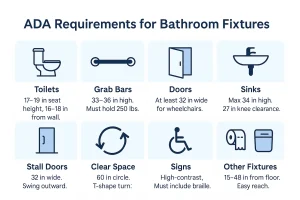Every business owner wants less risk and more opportunity. ADA compliance makes sure your facilities are accessible. By ensuring your facilities are accessible, you’re not only avoiding significant fines and legal penalties, but you’re also opening your doors to a wider audience. It’s a smart investment that benefits your bottom line and your brand.
What Is an ADA-Compliant Bathroom?
An ADA-compliant bathroom follows the rules in the Americans with Disabilities Act (ADA). These rules keep restrooms safe. They make them comfortable and easy to use for everyone. They are especially important for people with disabilities.
An ADA bathroom looks different from a regular one. The doors are wider. Wheelchairs can pass through easily. The stalls have more space. People can turn and move inside. Grab bars are fixed to the walls. They give support. Sinks, toilets, and fixtures are set at the right height. There is also clear space for movement. These small features matter. They help people stay safe and let people use the bathroom with dignity.
All public places must follow ADA rules. This includes shops, restaurants, and offices. It includes every place open to the public. Not following the ADA rules is costly and risky. The first fine is $55,000 to $75,000. A second fine can reach $150,000.
But ADA compliance shows that your business cares about people. It proves you value access for everyone and makes sure no one feels excluded. Following ADA rules is more than just obeying the law. It builds a welcoming place. It helps customers. It helps employees. It helps every visitor.
Minimum ADA Bathroom Size
The ADA does not set a strict minimum size for bathrooms. The law focuses on accessibility. The size of the restroom depends on how the space is laid out. It also depends on how the fixtures are arranged. The goal is clear. People with disabilities should be able to enter, move, and use the space without barriers.
Several factors affect the size. The placement of toilets, sinks, and stalls matter. The amount of floor space in front of these fixtures is important. Doors need enough clearance to open and close. They must not block someone’s movement. The design must also leave room for a wheelchair to turn safely. In practice, this means a five-foot turning circle. It can also mean a T-shaped turning area with three feet of clearance on each side.
Builders often start with 60 inches wide by 56 inches deep. This size works well for stalls and small restrooms. It gives enough space for turning and allows basic maneuvering. But the exact size will depend on the layout and the fixtures you choose.
State and local codes may require more space. For example, California’s Title 24 standards often require larger clearances. The ADA gives the baseline. Local laws can set the bar higher.
Minimum ADA size is not only about numbers. It is about making bathrooms usable. A well-designed restroom gives freedom of movement and safety. And it protects dignity for anyone who needs it.
Bathroom Stall Dimensions
Every ADA restroom needs at least one stall that is fully accessible. This stall should be easy and comfortable to use. It must also give enough space for people in wheelchairs.
The stall has to be 60 inches wide. This width makes it possible for a wheelchair to enter and turn. The depth changes with the type of toilet. A wall-mounted toilet needs 56 inches of depth. A floor-mounted toilet needs 59 inches of depth.
These sizes give the room needed to move around. They also make it easier to transfer onto the toilet and exit without struggle.
ADA Requirements for Fixtures

Toilets
An ADA-compliant toilet is not just about the height. It is about making the whole space functional and safe for everyone. The seat height is 17-19 inches from the floor. This is a specific height required to make transfers from a wheelchair much easier and safer. Actually, the height lines up with a wheelchair seat. This reduces the strain of a transfer. The toilet’s position, 16-18 inches from the side wall, is also crucial. This measurement ensures enough space. Users can position themselves for a side transfer easily. Finally, flush controls must be simple to operate. They should be easy to reach and push.
Bathroom Grab Bars
Grab bars are not just an add-on but provide support and balance. Their height is standardized at 33-36 inches from the floor. It helps people whether they are standing up, sitting down, or moving from a wheelchair. The lengths are specific. The side bar is at least 42 inches. The rear bar is 36 inches. This ensures a person has constant support. Beyond the measurements, the rules focus on practical safety details. The bars must be strong enough to hold at least 250 pounds. They must have rounded edges. The fittings must not rotate. These details seem small. But they prevent falls and provide peace of mind.
Bathroom Doors
For a bathroom to be truly accessible, a person must be able to get inside. They must also be able to move around freely. For this purpose, the minimum width must be 32 inches and is not negotiable. It provides enough space for a standard wheelchair to pass through. Doors can open inward or outward. The key is to make sure there is enough clear space. This lets a wheelchair user move safely. This includes a turning space near the entry.
Bathroom Sink (Lavatory)
An ADA-compliant sink is all about being usable from a seated position. The maximum height is 34 inches. This ensures a wheelchair user can easily reach the basin and faucet. The design of the space underneath is equally important. There must be at least 27 inches of vertical space. This is for knee clearance. A person can roll their legs underneath the sink. This lets them get close enough to use it comfortably. A 48×30 inch space is required in front of the sink. This is a standard clear floor space. It lets a wheelchair user go straight to it, turn, and use it without them feeling confined.
Bathroom Stall Doors
An accessible bathroom stall is about more than just a wide opening. The door is a key part of the design. It gives a person with a wheelchair the space and control they need. At least one stall must have an accessible door. The door must be at least 32 inches wide. This allows for clear entry.
The door cannot swing inward. It cannot block the stall’s clear floor space. Most ADA stalls have a door that swings outward. This gives the user a full turning space inside. The hardware on these doors is also for accessibility. It must be easy to use with one hand. It should not need twisting or tight grasping. It must be located between 34 and 48 inches from the floor. These small details ensure a person can use the door without bending their body and needing a lot of strength.
Clear Floor Space
An ADA bathroom needs a lot of clear floor space. So, a person in a wheelchair can turn, reverse, and move without hitting walls or fixtures. The standard clear turning space is a 60-inch circle or a T-shaped space. It is essential for safety and independence. Forgetting this is a serious legal risk.
Bathroom Signs
ADA-compliant signs make sure everyone can find their way. The rules for bathroom signs are more than just a label on a door. They must include pictograms at least 6 inches high and make them easy to see from a distance.
Signs must also have braille and verbal descriptions for people who are blind or have low vision. Accessible stalls must display the International Symbol of Accessibility (ISA). This is the well-known wheelchair icon. It says the space is compliant and provides a sense of comfort and certainty.
Other Fixtures
Accessibility means that all the essential items are present within easy reach for a person in a wheelchair.
Trash and sanitary bins must be in reach. They are typically between 15 and 48 inches from the floor. They must not block the clear floor space. Toilet paper dispensers must be within a person’s reach and must not be behind a grab bar. The dispenser must also allow for continuous dispensing.
FAQs about ADA-Compliant Bathroom
What is an ADA-Compliant Bathroom?
An ADA bathroom follows rules from the Americans with Disabilities Act. The rules make the space safe and comfortable. It is also usable for everyone. This is especially for people with disabilities. It has wider doors and more space. It has grab bars. The fixtures are set at the right height. This is all for accessibility.
What Is the Minimum ADA Bathroom Size?
The ADA does not have a strict minimum size for a bathroom. Instead, the law focuses on making the space accessible. It must have a clear path for movement. It must have enough room for a wheelchair to turn. This usually means a five-foot turning circle. The final size depends on the layout and fixtures.
What Are the Key Dimensions for an ADA Bathroom Stall?
Every ADA restroom must have at least one accessible stall. That stall must be 60 inches wide. This size allows a wheelchair to fit and turn.
The depth can be 56 inches to 59 inches. The measurement depends on the toilet type. These sizes create enough space for safe movement and easy transfers.
What Are the Main ADA Rules for Bathroom Fixtures?
The ADA pays close attention to fixture design. The goal is to make everything simple and safe to use..
Toilets must be 17 to 19 inches high. Grab bars must be installed at the right length and height.
This provides solid support. Sinks cannot be higher than 34 inches. There must be clear knee space underneath. This allows a wheelchair user to roll up.
What Are the Rules for Bathroom Signs and Other Small Fixtures?
Signs in an ADA bathroom must be easy to read. They must use high-contrast images. They must also include braille. Accessible stalls must be marked. They use the International Symbol of Accessibility like a familiar wheelchair icon.
Other small fixtures are also important. These include toilet paper holders and coat hooks. All fixtures must be placed at the right height. They must be easy for a wheelchair user to reach and use.





